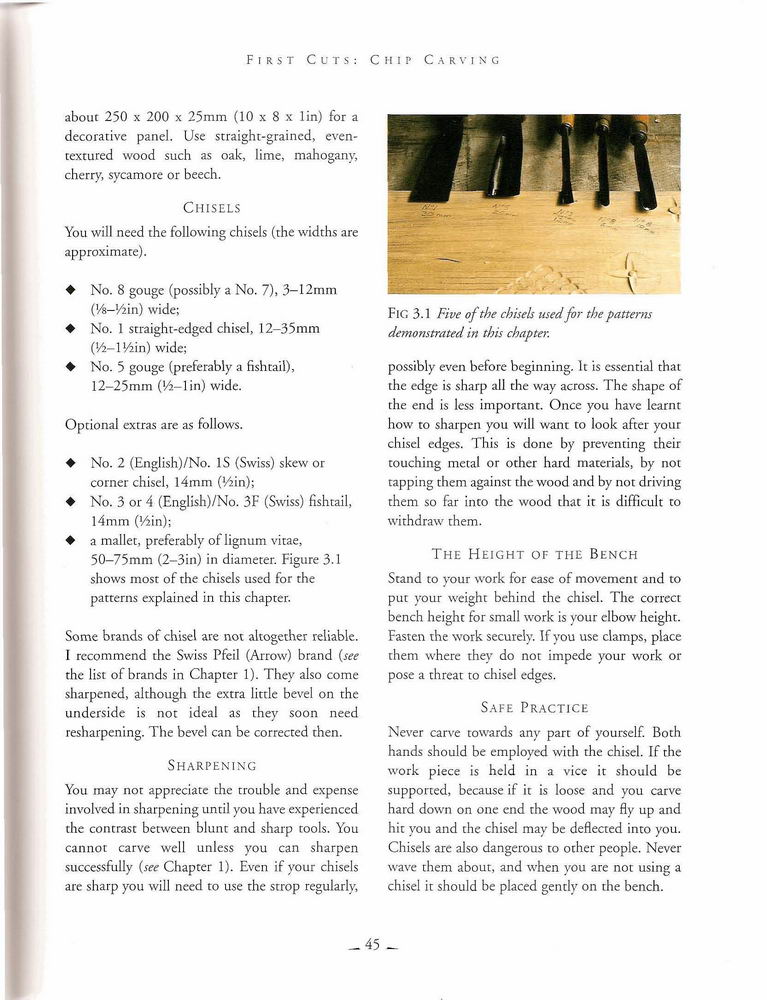essentÊrving°45

First Cuts: Chip C a r v i n g
about 250 x 200 x 25mm (10 x 8 x lin) for a decorativc panel. Use straight-graincd, cven-textured wood such as oak, limÄ™, mahogany, cherry, sycamore or beech.
Chisels
You will necd the following chisels (the widths are approximate).
♦ No. 8 gouge (possibly a No. 7), 3-12mm (V&—Vńn) wide;
♦ No. 1 straight-cdged chisel, 12-35mm (V£-lViin) wide;
♦ No. 5 gouge (preferably a fishtaii), l2-25mm (14-lin) wide.
Optional extras are as follows.
♦ No. 2 (English)/No. 1S (Swiss) skew or corner chisel, l4mm (Viin);
♦ No. 3 or 4 (English)/No. 3F (Swiss) fishtaii, l4mm (Viin);
♦ a mallet, preferably of lignum vitae, 50-75mm (2-3in) in diameter. Figurę 3.1 shows inost of rhe chisels uscd for the pattcrns explaincd in this chaptcr.
Some brands of chisel are not altogether reliable. I rccommend the Swiss Pfcil (Arrow) brand (see the list of brands in Chapter 1). They also come sharpcned, although the extra littlc bevel on the underside is not ideał as they soon need resharpening. The bevel can be corrected then.
Sharpening
You may not appreciatc the trouble and cxpense involved in sharpening until you have experienccd the contrast between blunt and sharp tools. You can not carvc wcll unless you can sharpen successfully (see Chapter 1). Evcn if your chisels are sharp you will need to use rhe strop regularly,

FlC 3.1 Five of the chisels used for the patterns dernonstrated in this chapter.
possibly evcn before beginning. lt is csscntial that the edge is sharp all the way across. The shape of the end is less important. Once you have learnt how to sharpen you will want to look after your chisel edges. This is done by preventing their touching metal or other hard matcrials, by not tapping them against the wood and by not driving them so far into the wood that it is difficult to withdraw them.
The Height of the Bench Stand to your work for casc of movemc»t and to put your wcight bchind the chisel. The correct bench height for smali work is your clbow height. Fasten the work securely. If you use clamps, place them where they do not impede your work or pose a threar to chisel edges.
Safe Practice
Never carve towards any part of yoursclf. Both hands should be employed with the chisel. If the work piece is hcld in a vicc it should be supporced, because if it is loose and you carve hard down on one end the wood may fly up and hit you and the chisel may be deflected into you. Chisels are also dangerous to other people. Nevcr wave them about, and when you are not using a chisel it should be placed gently on the bench.
— 45 —
Wyszukiwarka
Podobne podstrony:
essent?rving?49 First Cuts: Chip C a r v i n g Fig 3.9 A hole madÄ™ by rotating tbe No. 8 gotige whil
essent?rving?51 First Cuts: Chip C a r v i n g Fig 3.14 Startinga morÄ™ complex flower. The centre ri
essent?rving?44 CHAPTER 3FIRST CUTS: CHIP CARYING The Great Variety of Carving Tools Although sculpt
essent?rving?47 First C i t s: Chip C a r v i n c, Fig 3.3 The depth of the stab cut. exercise. Cut
Photo00252 I I I I 157. Jabłka 100 g 150 g 250 g 200 g 158. Śliwki 100 g 159. Truskawki 50 g 100 g 1
robotnicy PRZED 500 Ilość pracowników 450 400 350 300 250-200-150-1 GOŚĆCAi i i i i i mar 2014 maj 2
charakterystyki 1400 ---- 350 ----- 300 ---—---^ - 250 ----- 200
t 250noo 600 ; i « około 25 O m - -! 250 r 200^125 . •
Be the First to Hear about Other New Books from Revell!& =^l Sign up
DSC00171 (4) Promień tuku [ml fi 2 250 200 *1 fi < 250 ISO < fi < 200 260 S
300 300 rozpuszczalność (w g na lOOg wody) 250 200 150 100 f! >
więcej podobnych podstron